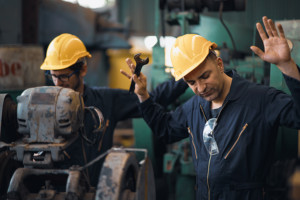 Overburden (muri) is one of the three evils of manufacturing, along with unevenness (mura) and waste (muda). Out of the three, overburden is probably the least understood. Hence, in this post I will look deeper at overburden, including plenty of examples as well as the effects of overburden on your people.
Overburden (muri) is one of the three evils of manufacturing, along with unevenness (mura) and waste (muda). Out of the three, overburden is probably the least understood. Hence, in this post I will look deeper at overburden, including plenty of examples as well as the effects of overburden on your people.
Introduction
There are three evils that every factory has to fight: waste (muda), unevenness (mura), and overburden (muri). I have written about them before. Normally, the focus of many companies is on waste, since it is the easiest of the three to address. However, unevenness is more significant, since it causes most of the waste. Finally, as claimed at Toyota, overburden is the worst of them all.
Yet, overburden often merely gets a passing glance when the shop floor is studied. In many cases, the meaning of the word is not even understood. Well, let’s first have a look at the actual Japanese word muri:
Muri (無理): unreasonableness; impossible; overdoing; beyond one's power; too difficult
In my view, overburden may be better translated as unreasonableness. While it’s not a literal translation, you could also see overburden as stress. The level is important here; a bit of occasional stress may be helpful, but frequently occurring stress usually is not. Keep in mind that different employees also have different tolerances.
Overall, when I walk through a shop floor (or any kind of company), I try to guess if I would feel comfortable working there. Keep in mind that not every job feels comfortable to every person. Furthermore, it is work and not a beach holiday, and a certain amount of tension may be acceptable. The question is if it is reasonable or not. Let’s have a look at some examples.
Examples of Overburden
 One example of overburden is a work overload. A short-term work overload may be acceptable. Employees can achieve quite a lot if there is an emergency—if they get some slower periods in between too. But running constantly at 130% is not good. If the emergencies never end, at one point they either stop caring or get burned out. In this case, it is a clear example of overburden that should have been prevented long ago.
One example of overburden is a work overload. A short-term work overload may be acceptable. Employees can achieve quite a lot if there is an emergency—if they get some slower periods in between too. But running constantly at 130% is not good. If the emergencies never end, at one point they either stop caring or get burned out. In this case, it is a clear example of overburden that should have been prevented long ago.
Similarly, but less common, is the opposite of a burnout, a bore-out. The employee has so little to do or such a tedious, mind-numbing task that he will have a bore-out. Note that different employees have different tolerances and even preferences on this.
 Generally, a physical or mental strain can lead to overburden. For a short period it can be acceptable, but in the longer run it may lead to health issues. In this case, it has been an overburden for a long time. But here, too, different employees have different abilities (for example, some government standards on lifting differentiate between men and physically weaker women).
Generally, a physical or mental strain can lead to overburden. For a short period it can be acceptable, but in the longer run it may lead to health issues. In this case, it has been an overburden for a long time. But here, too, different employees have different abilities (for example, some government standards on lifting differentiate between men and physically weaker women).
Another example of overburden is an unsafe workplace. If the health of the employee is at risk, either due to accidents and injuries or due to long-term effects like chemicals, noise, or lack of ergonomics, then it is an overburden.
An employee lacking equipment or not having equipment in proper working order is also an overburden. To do the work you need the right tools in good condition. Anything else, especially in the long run, is overburden.
 Or more generally, any lack of required resources is overburden. Giving the employee a task requires management to also give them the resources to do the task. This applies on the shop floor as well as in the office or elsewhere. Keep in mind that time is also a resource, and difficult or impossible deadlines are also overburden. This often combines with unrealistic expectations by others. Once in a while it’s okay, but frequent unrealistic expectations is overburden.
Or more generally, any lack of required resources is overburden. Giving the employee a task requires management to also give them the resources to do the task. This applies on the shop floor as well as in the office or elsewhere. Keep in mind that time is also a resource, and difficult or impossible deadlines are also overburden. This often combines with unrealistic expectations by others. Once in a while it’s okay, but frequent unrealistic expectations is overburden.
One aspect of the lack of resources is also a lack of training. An employee should be properly instructed on how to do his work; otherwise you cannot expect him to do his work properly.
Another example of overburden is inconsistency, especially from management. If management tells the employee to do it one way today but a different way tomorrow, it confuses the employee and leads to stress. The employee wants to deliver, but if the expected methods or results change frequently, it is hard to do that.
 One major point I often look at in a workplace is cleanliness, not only at the place of work or the rest areas, but also especially in sanitation. Unclean, smelly, defective, or otherwise lacking toilets are a prime example of overburden.
One major point I often look at in a workplace is cleanliness, not only at the place of work or the rest areas, but also especially in sanitation. Unclean, smelly, defective, or otherwise lacking toilets are a prime example of overburden.
All of these points above could be seen simply as a lack of respect. Respect for people, or respect for humanity, is a key part of lean manufacturing, and lack thereof is overburden. Disgruntled employees usually do not hate the company; they hate the managers, usually due to mistreatment or lack of respect. Here, it is not important if the manager feels like he respected the employee; it is only important if the employee feels respected.
What Are the Effects of Overburden?
There are quite a few effects of consistent overburden or stress. One is health issues. A burned-out employee may need not days but weeks or months of sick leave, causing significant disruption in operations, not to mention cost.
Employees may also vote with their feet and simply quit the company. All the training you put into them is lost, and in the worst case this may benefit the competition. Plus, you now have to make due without the employee until you hire and train a new one. It is quite a hassle.
 But probably the worst effict is having employees that internally quit, also known as quiet quitting. They no longer care about the company, they are just there for the money, and it doesn’t matter to them if the company has problems or not. Every company has a few such people—usually due to mistreatment by (previous?) management—and they are always a drag on operations.
But probably the worst effict is having employees that internally quit, also known as quiet quitting. They no longer care about the company, they are just there for the money, and it doesn’t matter to them if the company has problems or not. Every company has a few such people—usually due to mistreatment by (previous?) management—and they are always a drag on operations.
Overburden on Machines?
 It is also possible to have overburden on machines. A lack of maintenance, improper processing parameters (e.g., too-high speed or temperatures), improper types of materials (too hard, not uniform), or simply a lack of cleaning can also create undue stress for your processes. Similar to employees, an overburdened machine may also quit (i.e., have a breakdown, which in turn will disrupt your production). So please also do take care of your machines!
It is also possible to have overburden on machines. A lack of maintenance, improper processing parameters (e.g., too-high speed or temperatures), improper types of materials (too hard, not uniform), or simply a lack of cleaning can also create undue stress for your processes. Similar to employees, an overburdened machine may also quit (i.e., have a breakdown, which in turn will disrupt your production). So please also do take care of your machines!
This concludes this overview of what exactly overburden is. Now go out, check out the operators’ toilet in the farthest corner of the shop floor, consider if you would feel comfortable using it, and organize your industry!


Prof Roser, I know you’re not a huge fan of the US work culture, but that’s just about the top contender for the overwork poster child. I’m surprised you didn’t mention it. plus the fact that the employees’ mental and physical well-being is not a priority for most American companies.
In a way, workers are just like military aircraft where the engine power throttles will have settings between flight idle and full power. Fighter aircraft will often have an additional setting beyond normal full power. That’s the Wartime Emergency Power in case the pilot is a real spot of a bother. But this setting can only be safely used for a very short period of time and will burn up several engine hours (between overhauls) in a minute or less.
Likewise, most people are capable of extraordinary effort in an emergency. Trouble is, one day’s extraordinary effort combined with fortunate circumstances often becomes the permanent daily goal. and yes, working in that mode every goddamn day with no light at the end of the tunnel will burn people out to the point where most of the workforce in a company is either new people or people who are too burned to care anymore.
Have you heard of the strikes and walkouts by healthcare workers here in the US. The wages aren’t the issue, but it’s the staffing levels and the workloads where there’s barely enough time to do the job while cutting every single corner possible, nevermind doing things by the book or dealing with complications.
Here’s an outstanding example where a pregnant patient was given abortion pills by mistake.
https://www.google.com/amp/s/www.foxbusiness.com/healthcare/woman-mistakenly-given-abortion-medication-by-cvs-instead-of-ivf-hormones-they-just-killed-my-baby.amp
Of course there was a whole raft of documented administrative procedures and cross checks that would have prevented this. But, as usual, there’s no legally enforceable framework to require employers to ensure there’s enough time and staffing to follow the letter of the procedure, so corner cutting becomes a necessity. it doesn’t help that companies like Amazon or Starbucks deliberately write safety procedures that are physically impossible to keep up with. Workers who cut corners get a pass on not following the rules, while union agitators and such are routinely fired for either inability to follow safety rules or for low productivity (in case try to follow the rules and can’t keep up with the workers who don’t).